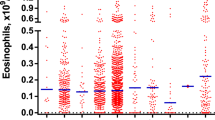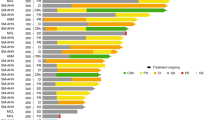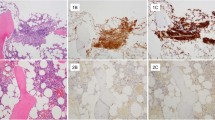Abstract
Systemic mastocytosis (SM) is a heterogeneous disease with altered interleukin (IL)-6 and IL13 plasma levels. However, no study has simultaneously investigated the plasma levels of IL1β, IL6, IL13, CCL23 and clusterin in SM at diagnosis and correlated them with disease outcome. Here we investigated IL1β, IL6, IL13, CCL23 and clusterin plasma levels in 75 SM patients—66 indolent SM (ISM) and 9 aggressive SM—and analyzed their prognostic impact among ISM cases grouped according to the extent of hematopoietic involvement of the bone marrow cells by the KIT D816V mutation. Although increased IL1β, IL6 and CCL23 levels were detected in SM patients versus healthy controls, only IL6 and CCL23 levels gradually increased with disease severity. Moreover, increased IL6 plasma levels were associated with ISM progression to more aggressive disease, in particular among ISM patients with multilineal KIT mutation (ISM-ML), these patients also showing a higher frequency of organomegalies, versus other ISM-ML patients. Of note, all ISM patients who progressed had increased IL6 plasma levels already at diagnosis. Our results indicate that SM patients display an altered plasma cytokine profile already at diagnosis, increased IL6 plasma levels emerging as an early marker for disease progression among ISM cases, in particular among high-risk ISM patients who carry multilineage KIT mutation.
This is a preview of subscription content, access via your institution
Access options
Subscribe to this journal
Receive 12 print issues and online access
$259.00 per year
only $21.58 per issue
Buy this article
- Purchase on Springer Link
- Instant access to full article PDF
Prices may be subject to local taxes which are calculated during checkout



Similar content being viewed by others
References
Lennert K, Parwaresch MR . Mast cells and mast cell neoplasia: a review. Histopathology 1979; 3: 349–365.
Valent P, Sperr WR, Schwartz LB, Horny HP . Diagnosis and classification of mast cell proliferative disorders: delineation from immunologic diseases and non-mast cell hematopoietic neoplasms. J Allergy Clin Immunol 2004; 114: 3–11, quiz 2.
Metcalfe DD . The liver, spleen, and lymph nodes in mastocytosis. J Invest Dermatol 1991; 96: 45S–46S.
Horny HP, Metcalfe DD, Bennet JM, Bain BJ, Akin C, Escribano L et alMastocytosis. In: Swerdlow SH, Campo E, Harris NL, Jaffe ES, Pileri SA, Stein H et al eds World Health Organization (WHO) Classification of Tumours Pathology and Genetics of Tumours of Haematopoietic and Lymphoid Tissues, 4th edn. International Agency for Research on Cancer (IARC): Lyon, 2008; pp 54–63.
Garcia-Montero AC, Jara-Acevedo M, Teodosio C, Sanchez ML, Nunez R, Prados A et al. KIT mutation in mast cells and other bone marrow hematopoietic cell lineages in systemic mast cell disorders: a prospective study of the Spanish Network on Mastocytosis (REMA) in a series of 113 patients. Blood 2006; 108: 2366–2372.
Orfao A, Garcia-Montero AC, Sanchez L, Escribano L . Recent advances in the understanding of mastocytosis: the role of KIT mutations. Br J Haematol 2007; 138: 12–30.
Akin C, Metcalfe DD . The biology of Kit in disease and the application of pharmacogenetics. J Allergy Clin Immunol 2004; 114: 13–19, quiz 20.
Alvarez-Twose I, Jara-Acevedo M, Morgado JM, García-Montero AC, Sánchez-Muñoz L, Teodósio C et al. Clinical, immunophenotypical and molecular characteristics of well-differentiated systemic mastocytosis. J Allergy Clin Immunol 2015; e-pub ahead of print 19 June 2015; doi:10.1016/j.jaci.2015.05.008.
Lim KH, Tefferi A, Lasho TL, Finke C, Patnaik M, Butterfield JH et al. Systemic mastocytosis in 342 consecutive adults: survival studies and prognostic factors. Blood 2009; 113: 5727–5736.
Escribano L, Alvarez-Twose I, Sanchez-Munoz L, Garcia-Montero A, Nunez R, Almeida J et al. Prognosis in adult indolent systemic mastocytosis: a long-term study of the Spanish Network on Mastocytosis in a series of 145 patients. J Allergy Clin Immunol 2009; 124: 514–521.
Teodosio C, Garcia-Montero AC, Jara-Acevedo M, Alvarez-Twose I, Sanchez-Munoz L, Almeida J et al. An immature immunophenotype of bone marrow mast cells predicts for multilineage D816V KIT mutation in systemic mastocytosis. Leukemia 2012; 26: 951–958.
Jara-Acevedo M, Teodósio C, Sánchez-Muñoz L, Alvarez-Twose I, Mayado A, Caldas C et al. Detection of the KIT D816V mutation in peripheral blood of systemic mastocytosis: diagnostic implications. Mod Pathol 2015; e-pub ahead of print 12 January 2015; doi:10.1038/modpathol.2015.72.
Matito A, Morgado JM, Alvarez-Twose I, Sanchez-Munoz L, Pedreira CE, Jara-Acevedo M et al. Serum tryptase monitoring in indolent systemic mastocytosis: association with disease features and patient outcome. PLoS One 2013; 8: e76116.
Brockow K, Akin C, Huber M, Metcalfe DD . IL-6 levels predict disease variant and extent of organ involvement in patients with mastocytosis. Clin Immunol 2005; 115: 216–223.
Nedoszytko B, Niedoszytko M, Lange M, van Doormaal J, Glen J, Zablotna M et al. Interleukin-13 promoter gene polymorphism -1112C/T is associated with the systemic form of mastocytosis. Allergy 2009; 64: 287–294.
Hartmann K, Wagner N, Rabenhorst A, Pflanz L, Leja S, Forster A et al. Serum IL-31 levels are increased in a subset of patients with mastocytosis and correlate with disease severity in adult patients. J Allergy Clin Immunol 2013; 132: 232–235.
Adams DH, Lloyd AR . Chemokines: leucocyte recruitment and activation cytokines. Lancet 1997; 349: 490–495.
Teodosio C, Garcia-Montero AC, Jara-Acevedo M, Sanchez-Munoz L, Pedreira CE, Alvarez-Twose I et al. Gene expression profile of highly purified bone marrow mast cells in systemic mastocytosis. J Allergy Clin Immunol 2013; 131: 1213–1224, e1–4.
Valent P, Horny HP, Escribano L, Longley BJ, Li CY, Schwartz LB et al. Diagnostic criteria and classification of mastocytosis: a consensus proposal. Leuk Res 2001; 25: 603–625.
Horny HP, Sotlar K, Valent P, Hartmann K . Mastocytosis: a disease of the hematopoietic stem cell. Dtsch Arztebl Int 2008; 105: 686–692.
Valent P, Akin C, Escribano L, Fodinger M, Hartmann K, Brockow K et al. Standards and standardization in mastocytosis: consensus statements on diagnostics, treatment recommendations and response criteria. Eur J Clin Invest 2007; 37: 435–453.
Rodriguez-Caballero A, Garcia-Montero AC, Bueno C, Almeida J, Varro R, Chen R et al. A new simple whole blood flow cytometry-based method for simultaneous identification of activated cells and quantitative evaluation of cytokines released during activation. Lab Invest 2004; 84: 1387–1398.
Rueff F, Przybilla B, Bilo MB, Muller U, Scheipl F, Aberer W et al. Predictors of severe systemic anaphylactic reactions in patients with Hymenoptera venom allergy: importance of baseline serum tryptase-a study of the European Academy of Allergology and Clinical Immunology Interest Group on Insect Venom Hypersensitivity. J Allergy Clin Immunol 2009; 124: 1047–1054.
Akin C, Valent P . Diagnostic criteria and classification of mastocytosis in 2014. Immunol Allergy Clin North Am 2014; 34: 207–218.
Akin C, Schwartz LB, Kitoh T, Obayashi H, Worobec AS, Scott LM et al. Soluble stem cell factor receptor (CD117) and IL-2 receptor alpha chain (CD25) levels in the plasma of patients with mastocytosis: relationships to disease severity and bone marrow pathology. Blood 2000; 96: 1267–1273.
Pardanani A, Finke C, Abdelrahman RA, Lasho TL, Hanson CA, Tefferi A . Increased circulating IL-2Ralpha (CD25) predicts poor outcome in both indolent and aggressive forms of mastocytosis: a comprehensive cytokine-phenotype study. Leukemia 2013; 27: 1430–1433.
Theoharides TC, Boucher W, Spear K . Serum interleukin-6 reflects disease severity and osteoporosis in mastocytosis patients. Int Arch Allergy Immunol 2002; 128: 344–350.
Rabenhorst A, Christopeit B, Leja S, Gerbaulet A, Kleiner S, Forster A et al. Serum levels of bone cytokines are increased in indolent systemic mastocytosis associated with osteopenia or osteoporosis. J Allergy Clin Immunol 2013; 132: 1234–7 e7.
Nardelli B, Tiffany HL, Bong GW, Yourey PA, Morahan DK, Li Y et al. Characterization of the signal transduction pathway activated in human monocytes and dendritic cells by MPIF-1, a specific ligand for CC chemokine receptor 1. J Immunol 1999; 162: 435–444.
Sims JE, Smith DE . The IL-1 family: regulators of immunity. Nat Rev Immunol 2010; 10: 89–102.
Essabbani A, Garcia L, Zonetti MJ, Fisco T, Pucci S, Chiocchia G . Exon-skipping strategy by ratio modulation between cytoprotective versus pro-apoptotic clusterin forms increased sensitivity of LNCaP to cell death. PLoS One 2013; 8: e54920.
Trougakos IP, Djeu JY, Gonos ES, Boothman DA . Advances and challenges in basic and translational research on clusterin. Cancer Res 2009; 69: 403–406.
Acknowledgements
This work was supported by Fondo de Investigaciones Sanitarias (FIS) of the Instituto de Salud Carlos III, Ministerio de Economía y Competitividad, Madrid, Spain (grant PI11/02399, FEDER), and Fundacion Ramon Areces, Madrid, Spain (grant CIVP16A1806). AM and AR-C were supported by a grant RTICC (Red Tematica de Investigacion Cooperativa en Cancer, grant RD12/0036/0048, FIS, FEDER). SM was supported by Fundación Científica de la Asociación Española contra el Cáncer. We gratefully acknowledge Juan Alejandro Flores Montero for his contribution in the recruitment of the controls.
Author information
Authors and Affiliations
Corresponding author
Ethics declarations
Competing interests
The authors declare no conflict of interest.
Additional information
Supplementary Information accompanies this paper on the Leukemia website
Supplementary information
Rights and permissions
About this article
Cite this article
Mayado, A., Teodosio, C., Garcia-Montero, A. et al. Increased IL6 plasma levels in indolent systemic mastocytosis patients are associated with high risk of disease progression. Leukemia 30, 124–130 (2016). https://doi.org/10.1038/leu.2015.176
Received:
Revised:
Accepted:
Published:
Issue Date:
DOI: https://doi.org/10.1038/leu.2015.176
This article is cited by
-
SWATH-MS identification of CXCL7, LBP, TGFβ1 and PDGFRβ as novel biomarkers in human systemic mastocytosis
Scientific Reports (2022)
-
Influence of ad Libitum Feeding of Piglets With Bacillus Subtilis Fermented Liquid Feed on Gut Flora, Luminal Contents and Health
Scientific Reports (2017)
-
Atopic diseases and inflammation of the brain in the pathogenesis of autism spectrum disorders
Translational Psychiatry (2016)



